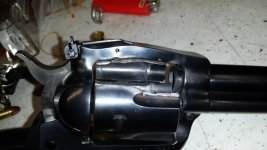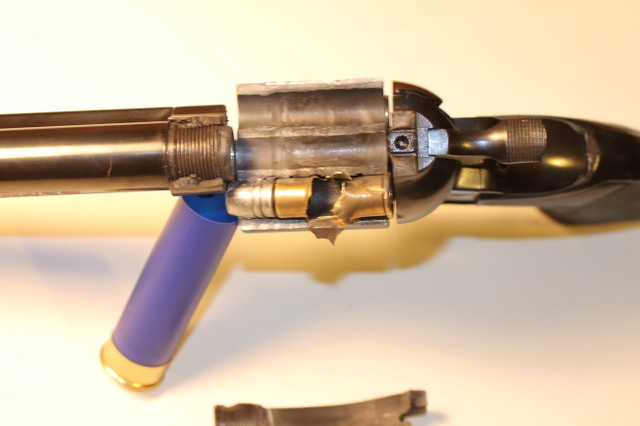Made a major mistake somewhere handloading for my 6 month old New Model Ruger Blackhawk 45Colt/ACP convertable. Used load date from the Nosler website for making a "Ruger only" load.
This time used 10.9gr of Unique, Starline 45 Colt brass topped with a 250gr Nosler Sporting Handgun Revolver bullet. Had previously tried 10.3 then 10.6 grains of Unique with no problem. OAL were all 1.600".
For crimping I use the Lee Factory Crimp Die. The crimp die is adjusted about a half turn lower from making contact with the case mouth.
The Starline cases are all brand new. I had to resize the cases because the bullets almost slid down inside the case with with no effort. Even after resizing the cases I didn't like how the bullets were so loose. I could finger push them into the case.
So this time I sized 3 cases using the 45ACP resizing die and loaded them with the above data. Bullets pushed into the case just like the other calipers I reload do.
Loaded all 3 shells into the Ruger and took the first shot over the chrono. Velocity was 973fps. Shot was a little smoky which I thought was unusual but then I saw the top half of my cylinder had blown off, top frame is bent and everything is jammed in place. Disbelief and surprised to say the least! Would have expected far more recoil or recoil pushed in a odd direction. The 2nd shell in line was blown out of the gun and torn open. I found those parts along with 2 pieces of the shell that blew. No sign of the cylinder pieces. Third shell is flattened and cracked still in the cylinder.
I count myself as extremely lucky I wasn't damaged. I am also concerned with what I did wrong in my reloading. Only been reloading for 2 years so still learning. I am assuming I set the scale counter weights wrong. I use a RCBS balance beam. I also have a Hornady electronic scale that I had quit using. Hated having to turn the thing back on all the time. Plan now is to set the counter weights on the balance beam scale, throw a charge and use the electronic scale to verify.
Is there anything else that could have prevented this from happening?
This time used 10.9gr of Unique, Starline 45 Colt brass topped with a 250gr Nosler Sporting Handgun Revolver bullet. Had previously tried 10.3 then 10.6 grains of Unique with no problem. OAL were all 1.600".
For crimping I use the Lee Factory Crimp Die. The crimp die is adjusted about a half turn lower from making contact with the case mouth.
The Starline cases are all brand new. I had to resize the cases because the bullets almost slid down inside the case with with no effort. Even after resizing the cases I didn't like how the bullets were so loose. I could finger push them into the case.
So this time I sized 3 cases using the 45ACP resizing die and loaded them with the above data. Bullets pushed into the case just like the other calipers I reload do.
Loaded all 3 shells into the Ruger and took the first shot over the chrono. Velocity was 973fps. Shot was a little smoky which I thought was unusual but then I saw the top half of my cylinder had blown off, top frame is bent and everything is jammed in place. Disbelief and surprised to say the least! Would have expected far more recoil or recoil pushed in a odd direction. The 2nd shell in line was blown out of the gun and torn open. I found those parts along with 2 pieces of the shell that blew. No sign of the cylinder pieces. Third shell is flattened and cracked still in the cylinder.
I count myself as extremely lucky I wasn't damaged. I am also concerned with what I did wrong in my reloading. Only been reloading for 2 years so still learning. I am assuming I set the scale counter weights wrong. I use a RCBS balance beam. I also have a Hornady electronic scale that I had quit using. Hated having to turn the thing back on all the time. Plan now is to set the counter weights on the balance beam scale, throw a charge and use the electronic scale to verify.
Is there anything else that could have prevented this from happening?
Attachments
Last edited:


